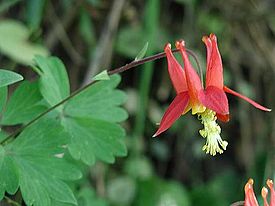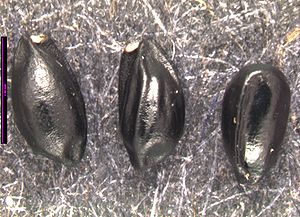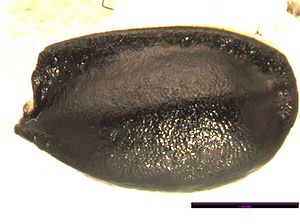Difference between revisions of "Aquilegia formosa"
| Line 1: | Line 1: | ||
| − | [[File:Aquilegia2.jpg|right| | + | [[File:Aquilegia2.jpg|right|275px|Aquilegia formosa]] |
| − | '''''Aquilegia formosa''''', commonly known as the red columbine, western columbine, or the Sitka columbine, is a flowering plant in the Ranunculaceae family.<br> <br> '''Synonyms:''' | + | '''''Aquilegia formosa''''', commonly known as the red columbine, western columbine, or the Sitka columbine, is a flowering plant in the Ranunculaceae family. <br><br> |
| + | '''Synonyms:''' | ||
| + | *''Aquilegia canadensis L. var. formosa'' | ||
| + | *''Aquilegia columbiana Rydb.'' | ||
| + | *''Aquilegia formosa Fisch. ex DC. in part [H&C, KZ99]'' | ||
| + | *''Aquilegia formosa Fischer ex de Candolle var. communis B. Boivin'' | ||
| + | *''Aquilegia formosa Fischer ex de Candolle var. megalantha B. Boivin'' | ||
| + | *''Aquilegia formosa Fischer var. wawawensis (Payson) H. St. John'' <ref>[http://biology.burke.washington.edu/herbarium/waflora/checklist.php?Taxon=Aquilegia%20formosa%20var.%20formosa Washington Flora Checklist]</ref> | ||
| − | * | + | |
| − | * | + | ===Taxonomy=== |
| − | * | + | *Kingdom Plantae – Plants |
| − | + | *Subkingdom Tracheobionta – Vascular plants | |
| − | + | *Superdivision Spermatophyta – Seed plants | |
| − | + | *Division Magnoliophyta – Flowering plants | |
| + | *Class Magnoliopsida – Dicotyledons | ||
| + | *Subclass - Magnoliidae | ||
| + | *Order Ranunculales | ||
| + | *Family Ranunculaceae – Buttercup family | ||
| + | *Genus Aquilegia L. – columbine | ||
| + | *Species Aquilegia formosa Fisch. ex DC. – western columbine | ||
| + | ===Description=== | ||
| + | Densely pubescent perennial from a branched to simple woody base with several stems 1.5-10 dm. tall. Long petiolate, mostly basal leaves 1.5-5.5 cm long. Pale to deep red flowers usually several, nodding; sepals 5, petal-like, oblong-lanceolate, 1.5-2.5 cm. long; petals 5, yellow, with straight spurs 10-15 mm. long, the blades 2-5 mm. long; stamens numerous, the inner ones sterile and scale-like. Follicles 5, 2 cm. long, copiously glandular-puberulent. <ref name="UW">[http://biology.burke.washington.edu/herbarium/imagecollection.php WTU Herbarium Profiles]</ref> | ||
| − | < | + | ===Bloom Period=== |
| + | May-August <ref name="UW"/> | ||
| + | ===Distribution=== | ||
| + | Widely distributed throughout Washington; Alaska south to California, coastal and inland to Alberta and Wyoming. <ref name="UW"/> | ||
| + | ===Habitat=== | ||
| + | Open woods, lowlands to mid-elevations in the mountains. <ref name="UW"/> | ||
| + | ===Uses=== | ||
| − | + | ===Propagation=== | |
| − | + | Follicles normally dry and split open at maturity. Gently crush dried seed heads to release remaining seeds; cleaned with "office clipper" air-screen. The papery, light pod chaff is easily separated from seed. Fairly long moist pre-chill improved germination; seeded cones stored for 6 months in a cold walk-in cooler with soil surface kept moist, produced more than 15% germination. Germination tests at Oregon State University seed lab were reported at just 8% with a 3-day prechill treatment. 3 to 5 seeds each were sown into Ray-leach SC-10 super cells filled with Fisons' Sunshine #1 potting mix, amended with 3-month slow-release Osmocote NPK fertilizer and small amounts of Micromax trace elements. Cones were well-watered and placed in to a walk-in cooler at 40 F for 6 months cold-stratification. Cones were moved outdoors to shadehouse in mid-spring to germinate. Initial germination is spotty, and initial growth is quite slow. Seedlings need light but fairly frequent watering to keep soil moist but not soggy. | |
| − | + | ||
| − | + | ||
| − | + | ||
| − | + | ||
| − | + | ||
| − | + | ||
| − | + | ||
| − | + | ||
| − | + | ||
| − | + | ||
| − | + | ||
| − | + | ||
| − | + | ||
| − | + | ||
| − | + | ||
| − | + | ||
| − | + | ||
| − | + | ||
| − | + | ||
| − | + | ||
| − | + | ||
| − | + | ||
| − | + | ||
| − | + | ||
| − | + | ||
| − | + | ||
| − | + | ||
| − | + | ||
| − | + | ||
| − | === Propagation === | + | |
| − | + | ||
| − | Follicles normally dry and split open at maturity. Gently crush dried seed heads to release remaining seeds; cleaned with "office clipper" air-screen. The papery, light pod chaff is easily separated from seed. Fairly long moist pre-chill improved germination; seeded cones stored for 6 months in a cold walk-in cooler with soil surface kept moist, produced more than 15% germination. Germination tests at Oregon State University seed lab were reported at just 8% with a 3-day prechill treatment. 3 to 5 seeds each were sown into Ray-leach SC-10 super cells filled with Fisons' Sunshine #1 potting mix, amended with 3-month slow-release Osmocote NPK fertilizer and small amounts of Micromax trace elements. Cones were well-watered and placed in to a walk-in cooler at 40 F for 6 months cold-stratification. Cones were moved outdoors to shadehouse in mid-spring to germinate. Initial germination is spotty, and initial growth is quite slow. Seedlings need light but fairly frequent watering to keep soil moist but not soggy. | + | |
| − | + | ||
| − | + | ||
| + | ===Seed=== | ||
'''Abbreviation:''' AQFO | '''Abbreviation:''' AQFO | ||
| Line 56: | Line 44: | ||
'''Measurement Range:''' L: 2.5 - 2.75, W: 1.2 - 1.5, D: 1 - 1.5 | '''Measurement Range:''' L: 2.5 - 2.75, W: 1.2 - 1.5, D: 1 - 1.5 | ||
| + | ====Features==== | ||
| − | + | '''Shape:''' Seeds tapering at hilum end, broadening at opposite side. | |
| − | + | ||
| − | '''Shape:''' Seeds tapering at hilum end, broadening at opposite side. | + | |
'''Color:''' Hilum is white, seed is black. | '''Color:''' Hilum is white, seed is black. | ||
| − | '''Surface:''' At least one distinct ridge runs from the hilum to the opposite side. End opposite hilum is sometimes puckered or having concave pits. Seed is glossy and lightly textured with very small bumps. | + | '''Surface:''' At least one distinct ridge runs from the hilum to the opposite side. End opposite hilum is sometimes puckered or having concave pits. Seed is glossy and lightly textured with very small bumps. |
| − | '''Latitudinal Cross Section:''' elliptical [[ | + | '''Latitudinal Cross Section:''' elliptical [[File:AQFO lat.png]] |
| − | '''Longitudinal Cross Section:''' obovate [[ | + | '''Longitudinal Cross Section:''' obovate [[File:AQFO long.png]] |
| + | |||
| + | [[File:Aquilegia formosa.jpg|300px|thumb|left|''Aquilegia formosa'']] | ||
| + | [[File:Aquilegia formosa single.jpg|300px|thumb|right|''Aquilegia formosa'']] | ||
| − | |||
| − | |||
{{Basics}} | {{Basics}} | ||
| − | + | ===Photo Gallery=== | |
| − | === Photo Gallery === | + | |
| − | + | ||
<gallery> | <gallery> | ||
File:Aquilegia2.jpg | File:Aquilegia2.jpg | ||
| Line 82: | Line 68: | ||
File:Aquilegia formosa single.jpg | File:Aquilegia formosa single.jpg | ||
</gallery> | </gallery> | ||
| − | + | ===References=== | |
| − | === References === | + | <References/> |
| − | + | ||
| − | < | + | |
Revision as of 08:58, 27 April 2012
Aquilegia formosa, commonly known as the red columbine, western columbine, or the Sitka columbine, is a flowering plant in the Ranunculaceae family.
Synonyms:
- Aquilegia canadensis L. var. formosa
- Aquilegia columbiana Rydb.
- Aquilegia formosa Fisch. ex DC. in part [H&C, KZ99]
- Aquilegia formosa Fischer ex de Candolle var. communis B. Boivin
- Aquilegia formosa Fischer ex de Candolle var. megalantha B. Boivin
- Aquilegia formosa Fischer var. wawawensis (Payson) H. St. John [1]
Contents
Taxonomy
- Kingdom Plantae – Plants
- Subkingdom Tracheobionta – Vascular plants
- Superdivision Spermatophyta – Seed plants
- Division Magnoliophyta – Flowering plants
- Class Magnoliopsida – Dicotyledons
- Subclass - Magnoliidae
- Order Ranunculales
- Family Ranunculaceae – Buttercup family
- Genus Aquilegia L. – columbine
- Species Aquilegia formosa Fisch. ex DC. – western columbine
Description
Densely pubescent perennial from a branched to simple woody base with several stems 1.5-10 dm. tall. Long petiolate, mostly basal leaves 1.5-5.5 cm long. Pale to deep red flowers usually several, nodding; sepals 5, petal-like, oblong-lanceolate, 1.5-2.5 cm. long; petals 5, yellow, with straight spurs 10-15 mm. long, the blades 2-5 mm. long; stamens numerous, the inner ones sterile and scale-like. Follicles 5, 2 cm. long, copiously glandular-puberulent. [2]
Bloom Period
May-August [2]
Distribution
Widely distributed throughout Washington; Alaska south to California, coastal and inland to Alberta and Wyoming. [2]
Habitat
Open woods, lowlands to mid-elevations in the mountains. [2]
Uses
Propagation
Follicles normally dry and split open at maturity. Gently crush dried seed heads to release remaining seeds; cleaned with "office clipper" air-screen. The papery, light pod chaff is easily separated from seed. Fairly long moist pre-chill improved germination; seeded cones stored for 6 months in a cold walk-in cooler with soil surface kept moist, produced more than 15% germination. Germination tests at Oregon State University seed lab were reported at just 8% with a 3-day prechill treatment. 3 to 5 seeds each were sown into Ray-leach SC-10 super cells filled with Fisons' Sunshine #1 potting mix, amended with 3-month slow-release Osmocote NPK fertilizer and small amounts of Micromax trace elements. Cones were well-watered and placed in to a walk-in cooler at 40 F for 6 months cold-stratification. Cones were moved outdoors to shadehouse in mid-spring to germinate. Initial germination is spotty, and initial growth is quite slow. Seedlings need light but fairly frequent watering to keep soil moist but not soggy.
Seed
Abbreviation: AQFO
Seed sample from: 2011
Average Measurement: 2.5 x 1.4 x 1.2
Measurement Range: L: 2.5 - 2.75, W: 1.2 - 1.5, D: 1 - 1.5
Features
Shape: Seeds tapering at hilum end, broadening at opposite side.
Color: Hilum is white, seed is black.
Surface: At least one distinct ridge runs from the hilum to the opposite side. End opposite hilum is sometimes puckered or having concave pits. Seed is glossy and lightly textured with very small bumps.
Latitudinal Cross Section: elliptical ![]()
Longitudinal Cross Section: obovate ![]()
Basic Explanations and Assumptions:
The dimensions for the seeds are length x width x depth. The location of the hilum is used as the base of the seed, and the length is measured from hilum to the opposite apex. Where a style is present, the length is measured from the hilum to the bottom of the style. Width is measured at a right angle to the length at the widest part. Depth is measured at a right angle to the intersection of height and width lines.
Measurements included are the mean average for each measurement of ten separate seeds.
All measurements in millimeters unless otherwise noted.






